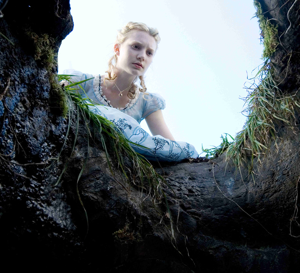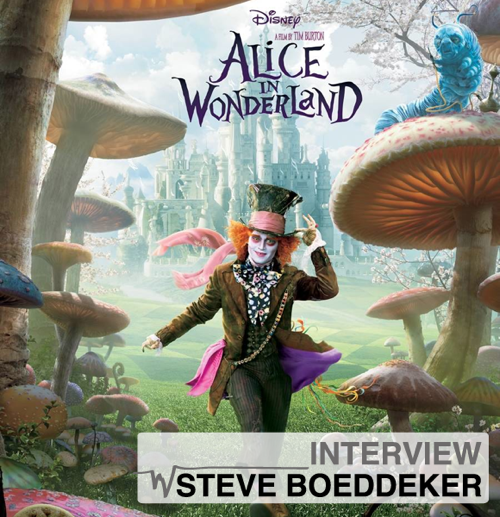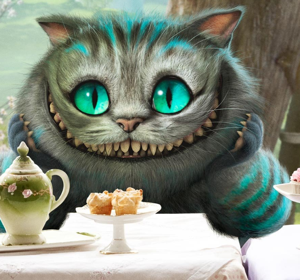Days ago I had the chance to interview Sound Designer, Supervising Sound Editor (and occasional Mixer and Composer) Steve Boeddeker, talking about his work as Sound Designer/Supervisor on Tim Burton’s Alice in Wonderland.
This interview is published at the same time of another at Filmsound Daily, there with Tom Johnson, Re-Recording Mixer of “Alice in Wonderland”. Don’t forget to check that one too!
Designing Sound: So, how do you get involved with “Alice in Wonderland”?
Steve Boeddeker: This is the fifth Tim Burton film I’ve worked on. As you might guess, Tim tends to turn to people that he has worked with before and who tend to “get it” when it comes to his creative sense. From Producers, to Actors to Composers to Sound…he has his usual cast of characters and doesn’t often seem to stray too far from the people he’s comfortable working with. He has an amazing sense for how all of the pieces of a film can come together and he’s really great at letting the team do their thing, so to speak. It frees him to always look at the big picture and make sure it all feels right in the end.
DS: How important is sound to Tim Burton in this film? How was your relationship with him?
SB: Tim is an incredible story teller and a very emotional film maker. He really relies on sound to not only help move the story and convey the emotion he’s looking for, but also to help give that Tim Burton feel. I feel like he wants his films to fit within the overall context of pop culture and film in general, so I really try to keep a realism and timeless funkiness to the sound and resist the temptation to create sounds or design scenes to be too over the top or distracting. If something about the sound calls too much attention to itself or seems gratuitously overdone it has to go. Story, character and emotion are what it’s about…so I try to make sure it all comes together in that way.
Tim usually likes me to just try things out and show him ideas and he’ll respond. So I try to get visual clues from the scene or character and figure out what he was going for when he shot it. Sometimes you can sense the influence of a certain film genre or an old TV show or something, but in this case there often wasn’t much to see other than green screen. So I started sending mixes of scenes and character sounds and we were able to focus in from there. I worked on the sound effects with the same London based crew we had for Sweeney Todd. David Evans, Steve Browell, Stefan Henrix and Andy Kennedy all were cutting in London and passing test mixes back and forth with me in San Francisco. We walked the Foley at Andy Malcolm’s facility and did the editing at Skywalker Sound with Jon Null, Brian Chumney and Pascal Garneau. Once we started mixing at Skywalker and Sony we got additional help from Dustin Cawood at Skywalker and at Sony we added effects editor Geoffrey Rubay. We were also fortunate enough to get Greg Russell to help out with the mixing. Truly an international crew.
 DS: What were your first thoughts about the sound when you was looking at the script, artwork, storyboards, etc? Is there an influence from the previous “Alice in Wonderland” stories and films?
DS: What were your first thoughts about the sound when you was looking at the script, artwork, storyboards, etc? Is there an influence from the previous “Alice in Wonderland” stories and films?
SB: Well, as I mentioned before, there wasn’t much to see in some of the scenes. We started working on scenes and character sounds, then we would load my mixes into the Avid and Tim would check them out and give feedback. Once a sequence or creature voice was working for him it was sent of to the VFX team to animate to. It was quite an amazing process actually. We ended up with a good bit of the Sound Design worked out early on but there were so many visual effects still to come and things were updating and changing right up to the very end. We could all tell right away that it was going to be a crazy mix with changes and updates coming in every day.
DS: What was the biggest challenge you found in the film?
SB: With any film, the first step in sound design is getting a feel for the film and deciding what you want it to sound like. For me it’s usually an emotional thing in that I’ll watch it and let ideas just come to me and I’ll jot them down or even dive right in and try them. Of course you need to try to adopt the creative style of the director as much as possible, but having worked with Tim Burton on 4 previous films, that wasn’t too difficult. What was a challenge however was that we were working with so much green screen and visual effects that were in varying states of completion. Initially some shots had rough animation and others were just actors in front of a green screen. So when I started it wasn’t really possible to “feel” what was the right direction. You imagine what it might look like and try ideas based on that but it was really hard to feel how well things were working. Chris Lebenzon, the Picture Editor, was really great about getting me early shots and scenes to work to and we were able to get a lot of the sound design figured out so that the VFX crew could actually animate to the sound.
DS: So, you have to create a new world, with fantastic creatures, places and a lot of fun with fantastic scenes… How do you get started to create this new palette of sounds?
SB: What David Evans and I decided to do was split the film into several pieces. The beginning and end take place in the English Countryside so it made sense for the London Crew to handle those scenes. Then we went through the film and split the sound work between the more realistic sounds and the more exotic. In other words they were able to focus on realistic sounds (like horses, dogs, Red Knight armor etc.) while I was concentrating on more exotic sounds like creature vocals (JubJub Bird, Bandersnatch, Jabberwocky, Hedgehog, etc) and surreal sounds (Cheshire Cat Appears, Exotic Backgrounds, etc.). Of course there was plenty of overlap between us but with some sounds it’s better to have options and see how things come together with the final visual effects and music score.
DS: Now let’s talk about the ambiences and all this different textures. You had to “carry” Alice in a lot of different places, from beautiful and clean to desolate and gloomy. What was the challenge for the sound there? How you make the audience feel like they’re in wonderland?
SB: Well, this was a pretty big challenge actually. Because you want the audience to wonder if Wonderland (or Underland) is real or just a dream, we wanted the sounds to do the same. Sometimes these locations are anchored in with sounds based in reality and other times they’re exotic and strange. But as I mentioned before, with Tim Burton you don’t really want the sound to jump out and proclaim “I’m a strange sound!!!”….rather it’s better to be supporting the reality that is being created visually and let the audience come to the conclusion themselves that “this is a strange place”. In the end you have to believe it.
As Alice first enters Underland there’s a mix of real and exotic sounds. Wind and insects with exotic birds and distant creature calls. Visually it looks like a real forest, all be it a strange one, so it needed to sound the same. And as she walks further in it gets “curiouser and curiouser”, as she says. I also really wanted to play up the difference between the White Queens’s Castle and the Red Queen’s Castle. The White Queen’s world is full of life and beauty so the sounds are rich with life and very comforting. But the Red Queen’s world is stark and cold. Animals and wildlife are terrified of her so there’s very little life. And Tim specifically suggested that the sound of the Red Queen’s Castle should be stark and cold as everyone inside is trying not to draw attention to themselves. A few animal sounds here and there to support the monkeys and pigs but much of the sound is her forceful walking and booming voice.
DS: And what about the creatures? both small such as the rabbits, mouses, insects and and big ones such as the Jabberwocky. I think you have a lot of stories about the creation of those characters…
SB: Yeah the creatures were a focus of Tim’s very early on. He really wanted to establish their voices as early as possible so they could animate to the sound (and then he could really “feel” how well things were coming together along the way). He had some very specific ideas about a few creatures (like the JubJub Bird should remind you of the giant bird-like calls of old movies or the cartoon Johnny Quest) and other creatures he just wanted me to start trying things. The Bandersnatch was pretty tough because he needed to be big and fierce at times but also calm and comforting at others…almost purring. He was a combination of several animals but mostly vocalizations from my Great Dane Otis and some bear roars to give him a chestier airier roar. The Hedgehog was really fun to do because he is the only character that talks to Alice but without being voiced by an actor. So he needed to have lots of expression and emotion in his calls (I used a bunch of pitched sounds of a French Bulldog puppy as well as some small bird chirps and calls). So again they animated to the sounds I cut but I also sent a library of “chatty hedgehog” sound that I made so Chris and Tim could play even more. It was a great way to work them through.
DS: We see Alice in a very small form, a bigger one, sometimes more in a “human size”. How you use sound to enhance this perspective and the Alice’s point of view?
SB: We did play with the idea of having her whole world change as she grows and shrinks. Sounds get bigger and heavier as she shrinks and smaller and thinner as she grows. But it seemed like it could get a bit distracting and call too much attention to itself as a concept. So we ended up focusing more on her growing and shrinking and kept everything else as “normal” as it could be. Basically let the audience believe that she’s big or small and that the camera just happened to be there to catch it. And keep in mind that all of this was shot with green screen, so often some of the most “normal” sounds ended up being the things that made it the most believable. For example, when Alice makes her way across the Red Queen’s moat, we see her hopping from head to head, bobbing up and down in a sea of bloody water filled with heads everywhere you look. But in reality she was jumping from one green box to another to another in a big green room. So her interactions with the virtual world all needed sound. And the more small sounds, foley and breathing we added the more believable it became.
DS: Alice in Wonderland has been for me one of the best 3D experiences. There are a lot of moments with things passing around you, landing on your face, and a beautiful 3D detail in each scene. We know the sound is in 3D many years ago, but… How the 3D experience in the film affects the sound decisions?
SB: It’s an interesting phenomenon. You can really get away with a lot of sound tricks in 3D. We did most of our work in 2D because the 3D process is the last thing to happen once the visual effects are all finalized. So as we all were making, editing and mixing the sound effects we tried to always keep in mind that things will be more extreme in 3D. The Cheshire Cat won’t just fly off he will fly right over your head, and the Red Knights will seem to march right into the theater. So we tried to push the surrounds as much as possible knowing it will be much more believable in 3D. But once we were able to finally `listen to the mix against the finished 3D picture it was still an amazing and exciting experience. Michael was able to push up a lot more of the backgrounds and we could play up the surrounds much more but still believe what we were seeing and hearing. Again you just go by what feels right and make sure that in the end, you believe it really happened.


Tim Burton has a unique style when making his movie. I love Nightmare Before Christmas and Edward Scissorhands.,.;
Tim Burton is an eccentric director in my opinion but he has his own unique style`.;
tim burton does really have that unique style with regards to his movies**;
Thank you a lot for sharing this with all folks you actually understand what you’re speaking about! Bookmarked. Kindly also seek advice from my web site =). We could have a link alternate arrangement between us!
Whenever I visit this web site there’s new stuff and improved that i can study from. Haha I’ve been in your source code many times to understand how you’re doing things so I can wear them my site. Thanks! I am able to teach you about solutions to easy.